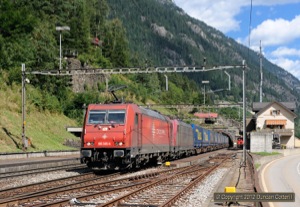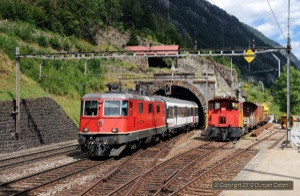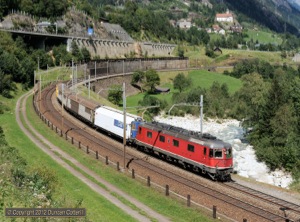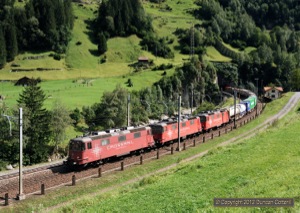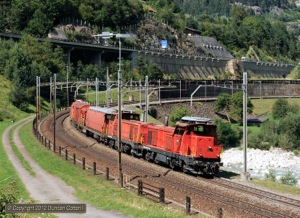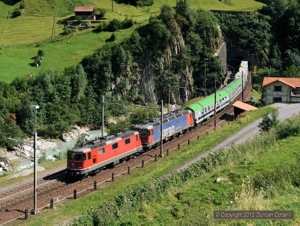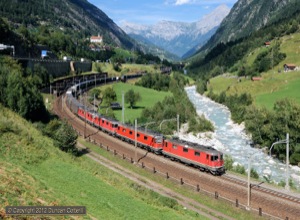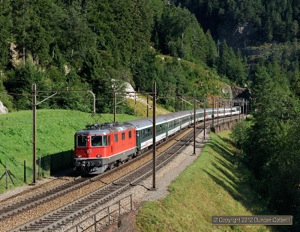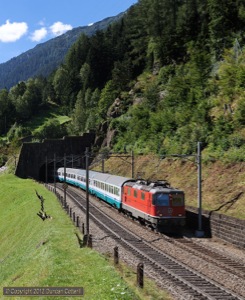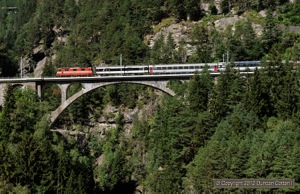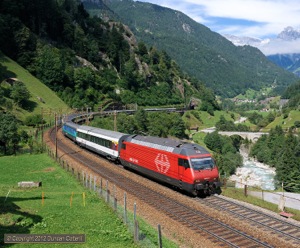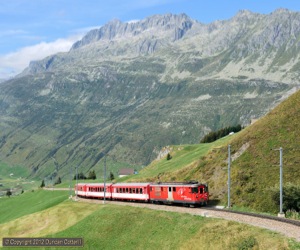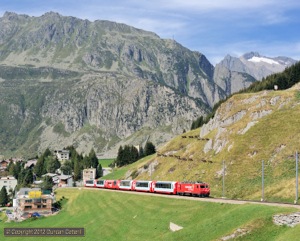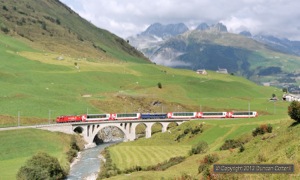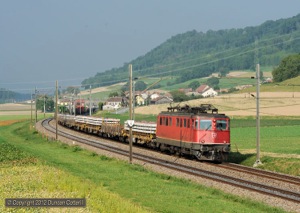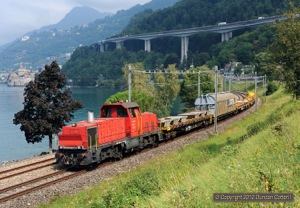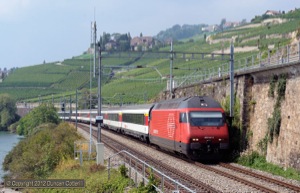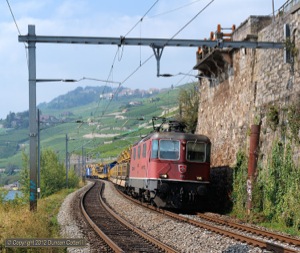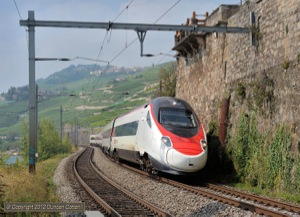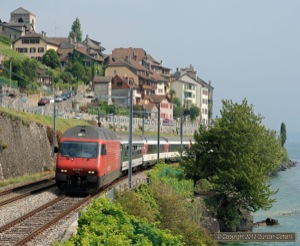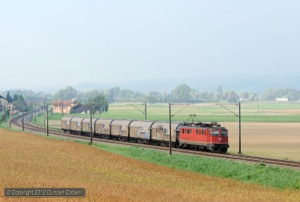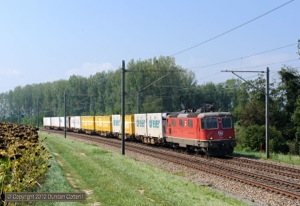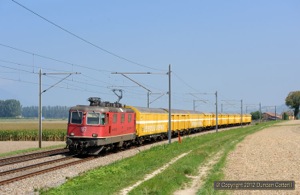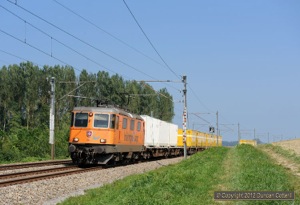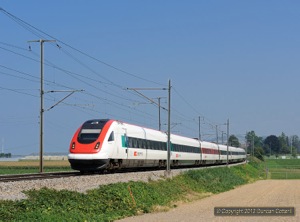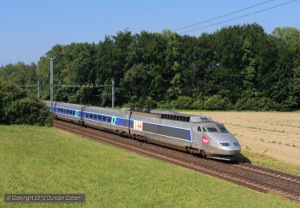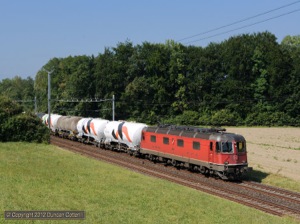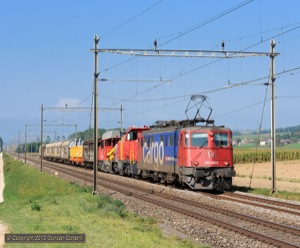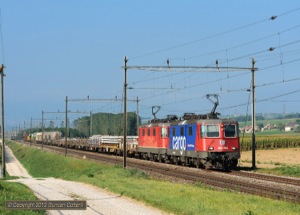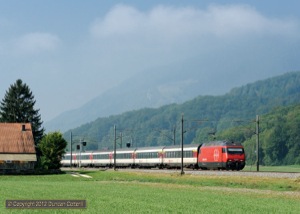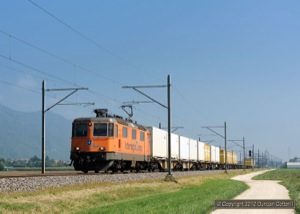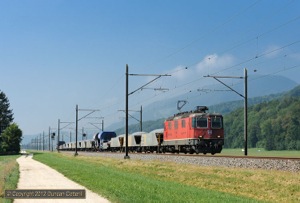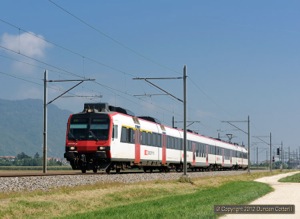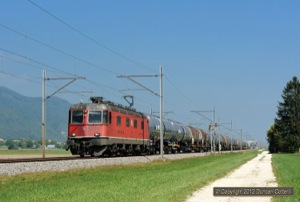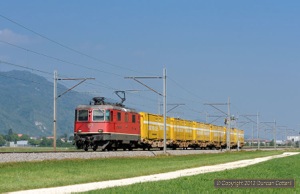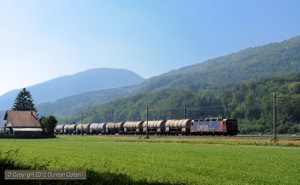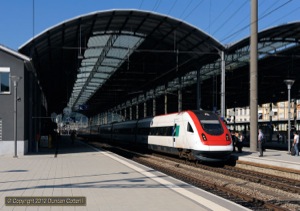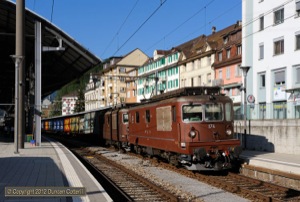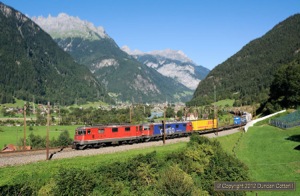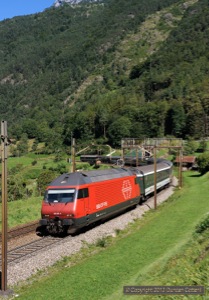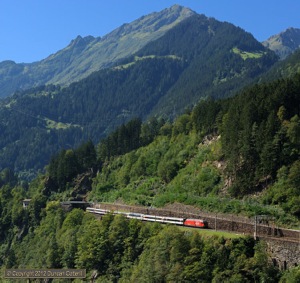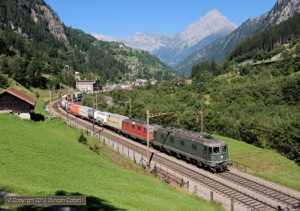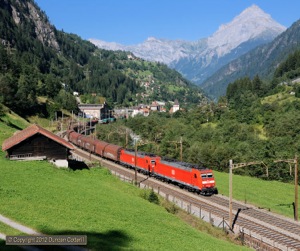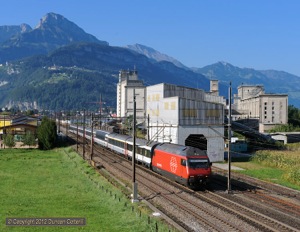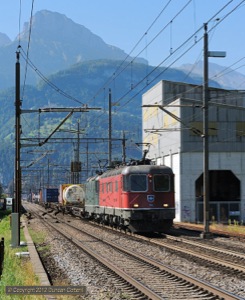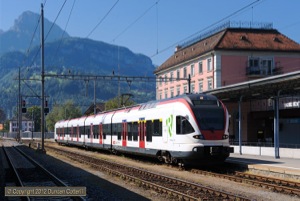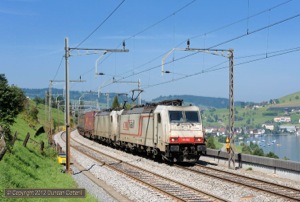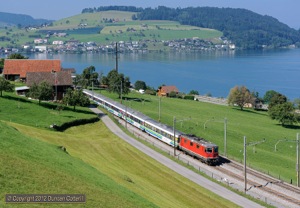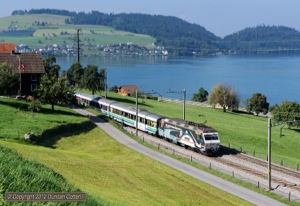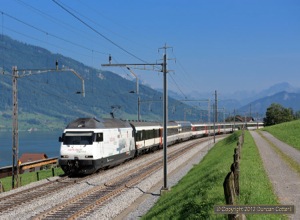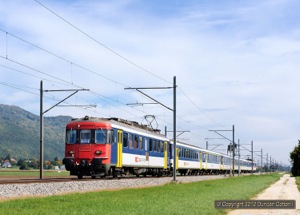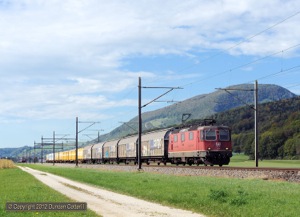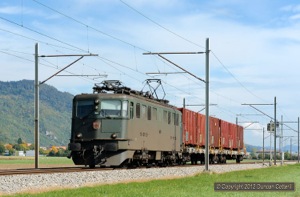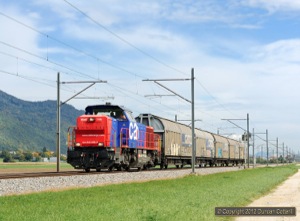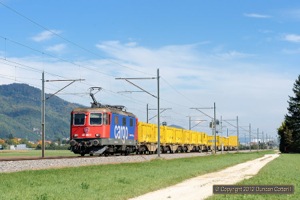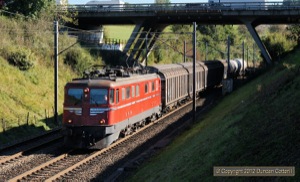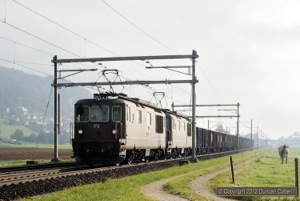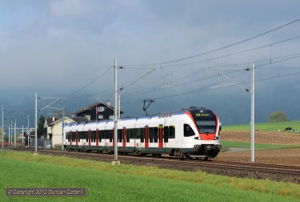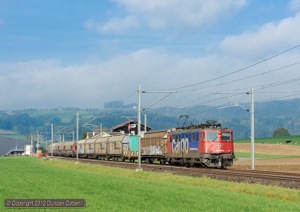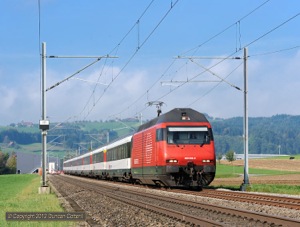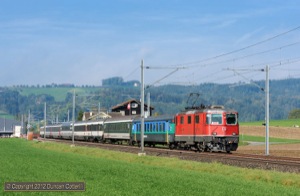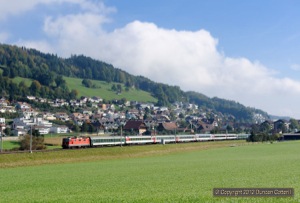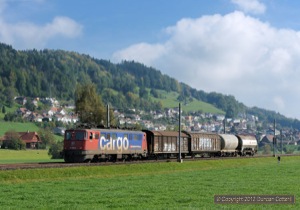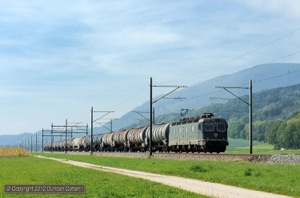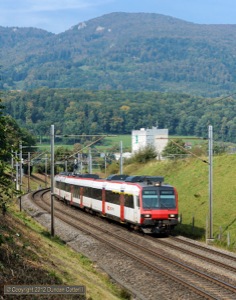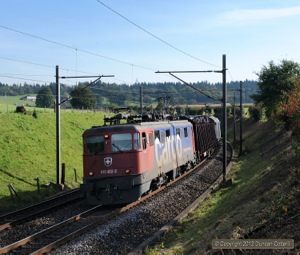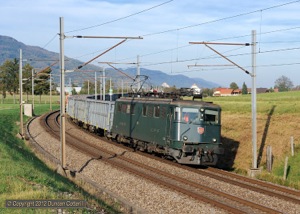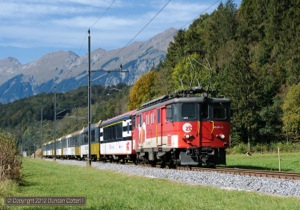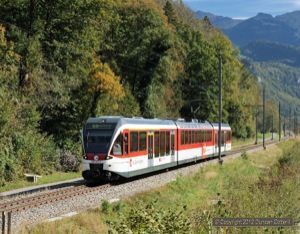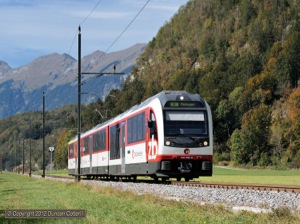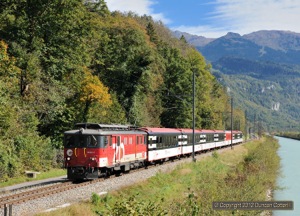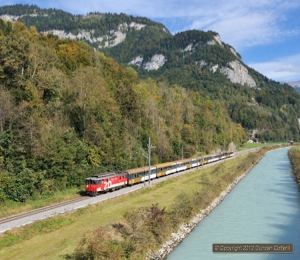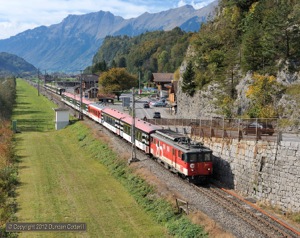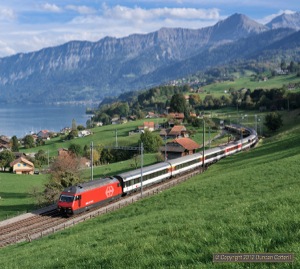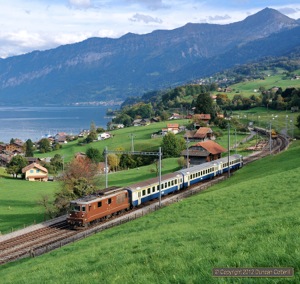Swiss Miscellany
29 August - 9 September & 02 - 07 October 2012
Report by Duncan Cotterill
Introduction
Despite numerous trips to the Rhätischebahn over the last few years, I hadn’t really done much photography in the rest of Switzerland. With the veteran class Ae6/6s in serious decline it was time to address the photographic deficit. This report covers two trips, a 12 day visit in late August and early September and another six days in early October. There were two main objectives, the Gotthard and Ae6/6s, but I also wanted to get a good selection of shots of Swiss main-line operations generally. The extent to which the objectives were achieved will become clear.
This section of the report summarises what was seen. For train by train details with loco numbers etc, go to the Day by Day pages.
Travel Arrangements
Flights from Heathrow to Zürich and back were with Swiss both times and hotels were booked through www.booking.com. Travel around Switzerland was mainly by rail, using a 15-day Swiss Pass for the first trip and a 6-day InterRail for the second.
The Gotthard Main Line
For the purposes of this report, at least, the Gotthard is taken as starting at Immensee, km post 0, to Chiasso, km post 206 on the Italian border. I spent eight days based on the Gotthard, from Wednesday 29 August to Monday 3 September and again on Saturday 8 and Sunday 9 September. Two dull days were spent travelling and another day on the MGB, of which more later, leaving five days for linesiding. Much has been written about the history and geography of the Gotthard main line and the base tunnel, currently under construction, which I won’t repeat here.
It was a good time to visit the Gotthard with freight traffic over the Brenner Pass to the east and through the Simplon Tunnel to the west badly affected by engineering work. Much of the freight traffic from those routes was diverted via the Gotthard but it was surprising that the line could handle the extra trains as there were two single-track sections to contend with. From Altdorf to the site of the junction for the base tunnel was being rebuilt with only a single track in place through the construction site. There was also engineering work around the site of the landslide beween Zgraggen and Gurtnellen. The southbound track was out of use every morning, including weekends, with all trains using the northbound track.
Passenger Trains
The mountain section of the Gotthard from Erstfeld to Biasca sees two or sometimes three passenger services in each direction every hour, running to a regular interval style pattern. The hourly InterRegio services from Zürich or Basel to Locarno, or occasionally Chiasso, are hauled by class 460 or Re4/4ii locos on conventional stock. Of the trains actually seen, 33 were booked for Re4/4iis and 42 for 460s but the actual balance was somewhat different with Re4/4s on 42 trains and 460s on 33. All the substitutions were during the first six days with everything running as diagrammed on the final weekend of the first trip.
There is also an hourly InterCity service from either Zürich or Basel to Lugano, some of which continue to Chiasso and a few, running under the EuroCity banner, go through to Milano. These trains are booked for tilting EMUs, with SBB class 500s on domestic services and FS or SBB class ETR470s on EC trains.
Interestingly the timetable is designed with the unreliability of the ETR470s in mind. Every EC is preceded by an ICN service running a few minutes ahead to maintain connections in the event of failures or late running. One pair of EC trains has been decelerated this year and was always haued by the booked SBB Cargo class 484 when seen. These trains, EC15 and EC22, take around 40 minutes longer than other services on the route. Three EC services were seen being operated by class 500 units, undoubtedly with a change of trains required at Chiasso, and EC14 was formed of FS hauled stock with an Re4/4ii in charge on the three occasions it was noted. Late running was common for northbound EC services, even those worked by the booked ETR470, and connections at Arth-Goldau were not held for more than a few minutes.
Away from the mountain section there are also local passenger services, mainly worked by Stadler “Flirt” EMUs of various denominations. These include dual-system class 524s on services in Ticino, branded as TiLo, many of which continue across the border into Italy.
The far northern end of the route from Arth-Goldau to Immensee also sees “Voralpen Express” services running from Luzern to Romanshorn. These trains are formed of distinctively liveried push-pull sets with the loco leading from Luzern. I had expected these services to be worked by SOB class 456 locos but at least two of the sets were powered by SBB class Re4/4ii locos instead, something I’ve since learned is normal but came as a pleasant surprise to me.
Freight Traffic
The Gotthard is one of three important trans-Alpine freight routes linking Germany with Italy. It’s normally busy but temporary closures of both the other lines pushed even more traffic over the line.
The majority of trains were intermodals, some containers, some swap bodies and some a mixture of both. Some services were dedicated to particular companies, e.g. Winner Spedition or Ambrogio, but the bulk carried goods for a variety of companies. The mix was enlivened by a pair of Ralpin RoLa (= Rollende Landstrasse = rolling road = complete lorries on rail wagons) trains as well. These were thought to be Freiburg im Breisgau (Germany) to Novara (Italy) services that normally run via the Lötschberg/Simplon route. Inexplicably, these trains, normally worked by BLS, were hauled by SBB traction.
There were also general freights, trains of steel coil, oil tanks, vans, stone hoppers and postal vans.
Despite the liberalisation of the freight market within Europe and the profusion of independent operators in both Germany and Italy, virtually every train seen was hauled by locos from one of only three different operators. Overall, SBB Cargo locos worked just over 50% of the 96 freights noted. The vast majority of these were worked by Re10/10s (Re4/4ii + Re6/6 double headers) although a few had pairs of Re4/4iis or single Re6/6s. Single Re4/4ii or Re6/6 were in use as bankers from Erstfeld to Göschenen with around 50% of trains taking a banker. There were a couple of departmental trains worked by Bm4/4 diesels but no class 482 were seen and the only class 484 noted were either light engine or stabled around Chiasso. No Ae6/6 were seen on freight trains although I wasn’t necessarily in the right place at the right time to see the few local freights they could have hauled. One Ae6/6 was on shed at Erstfeld over the weekend of 8-9 September and another two, seemingly complete and in reasonable condition, were seen being hauled north at Silenen on 8 September.
The partnership of DB and BLS worked 33% of the freights seen and this percentage held up, even after the Simplon route had reopened. DB class 185 predominated with the equivalent BLS class 485 working far fewer trains. Unlike SBB Cargo, DB tended to use single locos north of Erstfeld on most trains and added pilot engines and bankers for the climb to Göschenen. The banker would be detached at Göschenen but the pilot engine would continue through the tunnel and down the south ramp. There were always a number of class 185 stabled at Erstfeld awaiting their next duty and mixed combinations of DB and BLS power were not unknown. While the Simplon route was closed, pairs of BLS class 425 (Re4/4) “Brownies” were also in use on a few freight services but none were seen following its reopening. No class 465 or 486 were seen.
The third operator was Crossrail, which worked 14% of trains, exclusively intermodals. Most trains were worked by pairs of class 185 or 186 locos but the remaining three class 436 (Re4/4iii) were also seen, triple headed, on a couple of occasions. Crossrail trains operated without bankers.
The only other locos seen were hire engines; 186.101 (Railpool?) on NB car carriers on 7 September and two Dispolok double headers, possibly using the same locos, a 182 and a 189, on 8 September. There was often a Dispolok or two stabled at Erstfeld but these trains were the only ones I saw them working.
Photography
This was my third visit to the Gotthard. The first, in 2000, wasn’t particularly successful photographically and the second, in 2010, was one of the least productive trips I’ve ever done. At least this trip was moderately successful with around 50% sunshine and a good variety of shots in a number of different locations from Immensee to Göschenen. I did make a couple of exploratory visits to the south ramp but concluded that most of the good shots were on the other side.
I didn’t find photography particularly easy. My approach to taking pictures on electrified lines, or anywhere else, has always been to avoid poles growing out of the loco. This isn’t always straightforward around stations or junctions but out on the lineside, it’s usually possible to adjust your viewpoint and focal length to miss the poles without compromising the composition. That wasn’t the case on the Gotthard. The poles were so closely spaced in places that it was impossible to avoid poles behind the loco and difficult to avoid poles in front of the loco either, particularly with the longer locos such as Re6/6s or 460s. Careful selection of viewpoints was essential and there was an unusually high failure rate, mainly when locos turned out to be longer than anticipated.
Getting to the various locations on foot or using the local bus service between Erstfeld and Göschenen was relatively straightforward but the hour long gaps between buses did mean that timing of moves was critical if you weren’t going to waste too much time at the bus stop or, worse still, miss the bus and have to wait an hour for the next one. I made it every time but sometimes only because the bus was running late.
The Matterhorn – Gotthard Bahn
The MGB is a metre gauge line running from Zermatt via Visp, Brig, the Furka and Oberalp passes to a connection with the RhB at Disentis, hence the names of its predecessors, the Brig Visp Zermatt and the Furka Oberalp. It neither climbs the Matterhorn nor crosses the Gotthard Pass. Nor does it cross the Furka Pass any more, following the opening of a base tunnel in 1982. Although the line is adhesion worked for most of its length, there are a number steeply-graded, rack-equipped sections as well, including the branch from Andermatt to the Gotthard main-line at Göschenen. I visited the line twice, travelling from Brig to Göschenen as part of a round trip on Friday 31 August and then spending a day photographing either side of Andermatt on Monday 3 September.
Passenger Trains
The MGB operates a regular interval passenger service over the former Furka Oberalp with hourly trains from Visp (on the former BVZ) to Göschenen via Brig, the Furka Base Tunnel and Andermatt and from Andermatt to Disentis via the Oberalp Pass. There is also an additional pair of workings from Andermatt to Göschenen every hour for much of the day.
In the summer timetable period most of these trains are worked by class Deh4/4 motor luggage vans on 3-coach push-pull sets. Every train I saw on the Brig – Andermatt – Göschenen workings had the MLV at the east end but a number of trains on the Andermatt – Disentis section were the other way round, something I hadn’t expected. A number of workings had additional coaches added to the back of the train, meaning the MLV was in the middle of the formation when propelling.
The MGB’s class HGe4/4ii locomotives work most of the Andermatt – Disentis trains in winter but in summer they’re mostly employed on Glacier Express duties. Four pairs of trains run each day from Zermatt to Chur with three going on to St.Moritz and the fourth to Davos. This requires six locos as the engines on the first two eastbounds arrive at Disentis in time to work the last two westbounds. East of Disentis the Glacier Expresses are worked by the RhB. Each train consists of six specially built panoramic coaches, two firsts, a diner and three seconds in a co-ordinated white and red livery, however on the day I spent around Andermatt, one train in each direction had a vintage RhB dining car instead, spoiling the overall impression.
The MGB keeps a number of historic locos in working order for special trains. Former FO HGe4/4i 36 dates back to 1948, although the design dates from 1939 and it looks much older. It was seen at Andermatt on 31 August, probably waiting to go on shed. On 3 September it worked a special train east from Andermatt, formed of four RhB Pullman cars. The train was labelled as a Zermatt – St.Moritz private charter and had almost certainly overnighted at Andermatt.
MGB owned rack and adhesion diesel 61 was seen waiting to depart Oberwald on Dampfbahn Furka Bergstrecke metals on 31 August. This is the preserved section of the FO over the Furka Pass. Presumably this was the diesel traction referred to in the timetable as working train 155 from Gletsch to Oberwald.
Freight Traffic
The closest thing to a real freight train seen was Ge4/4 81 on a Furka Base Tunnel car shuttle at Realp.
Photography
After grappling with the closely spaced poles on the Gotthard, it was a real pleasure to spend a day on the MGB, where the single track and better pole spacing were a lot easier to cope with. Like the RhB, the MGB is a very photogenic railway.
The motor luggage vans that worked most trains aren’t locomotives but they photograph well and the all-over red livery differentiates them sufficiently from the red and cream coaching stock, giving the appearance of a loco and coaches rather than a multiple unit. That’s good enough for me.
Lausanne – Biel/Bienne
I moved from the Gotthard to Yvonand, close to Yverdon-les-Bains on the shore of Lake Neuchâtel, and spent the best part of 3 days photographing in the Lausanne area. The big attraction of the Lausanne – Yverdon – Neuchâtel – Biel/Bienne line was the continued use of class Ae6/6 locos on a handful of workings.
Passenger Trains
There aren’t many interesting passenger trains at the south end of the Lausanne – Biel line. The principal service consists of two pairs of Inter City trains an hour worked by class 500 tilting EMUs. These link Genève and Lausanne with St.Gallen (via Zürich) and Basel and run 3 minutes apart with a cross platform interchange in Biel. The Lausanne and Genève trains swap destinations every hour.
Local services between Yverdon and Lausanne are worked by EMUs. Class 523 “Flirt” units work an hourly all stations service from Yverdon to Villeneuve (at the east end of Lake Geneva) via Lausanne. Class 560 EMUs work a second hourly service from Yverdon to Lausanne, Monday to Friday only, calling only at principal stations.
The only loco worked trains are two pairs of InterRegios that run from Neuchâtel to Lausanne in the morning peak and return in the late afternoon. These were worked by Re4/4iis during my visit. The second northbound train IR1541 was formed of a push-pull set in push mode.
Freight Traffic
For a route that doesn’t form one of the main international freight corridors, this line sees a lot of freight traffic and trains of all types, many of them servicing local industries. In addition to general freight, containers, trains of oil tanks from refineries at Cornaux or St-Triphon, cement from Eclépens and dairy products from Estavayer-le-Lac, there was a lot of postal traffic, serving a mail depot at Eclépens and a parcels depot at Daillens, a few km to the south.
One thing all the freights had in common was the use of SBB Cargo motive power. In the whole time I was in the area, I didn’t see a freight hauled by any other operator. Most trains were single headed by class Re4/4ii locos although class Re6/6 weren’t uncommon. Ae6/6s were expected to be limited to three daylight trains, a morning Lausanne Triage – Estavayer-le-Lac van train and two late afternoon freights from Müntscheimer and Cornaux, both near Neuchâtel, to Lausanne Triage. Most of the time I was there, this was the case but on Thursday 6 September, everything seemed to be different.
The Estavayer train ran as normal with 11464 but then 610.439 worked the morning Eclépens to Yverdon freight and the afternoon Yverdon to Lausanne Triage freight . 610.519 worked the early evening Chavornay to Lausanne Triage freight. 610.439 returned north with the evening Daillens – Frauenfeld postal. 610.496 worked the booked Cornaux – Lausanne Triage freight and 11520 was seen waiting to leave Yverdon with a train of vans later in the evening.
I returned briefly to Neuchâtel on Wednesday 3 October and found the trip freight to Cottendart worked by an Re4/4ii instead of the hoped for Ae6/6.
Photography
The Yverdon – Lausanne section of the line runs through pleasant country with few really great locations but several very acceptable positions. Pole spacing was considerably better than on the Gotthard but was still problematic for double-headers. Footpaths and farm access tracks make access to the lineside relatively easy and stations every few km mean that there’s hardly anywhere that’s difficult to reach. As on the Gotthard, the hour’s gap between trains meant that moving between locations could be quite time consuming and the timing of moves was critical.
The area south of Neuchâtel is also fairly photogenic with some decent positions amongst the vineyards around Auvernier and Colombier.
The light was not particularly good for most of the time I was there but did clear up on the Thursday afternoon during the first trip, only to drop into a thick bank of cloud when the flood of Ae6/6s started in the evening. My only venture into the area on the second trip was quickly abandoned due to the weather being much worse than forecast.
In terms of Ae6/6 photography, the results were very disappointing. I saw nine trains hauled by the class, instead of the seven expected, and all the additional trains ran on the best day for the light. However, only one shot was in full sun with a couple more in half light.
Lausanne – Brig
This scenic line runs along the north shore of Lake Geneva, serving upmarket towns like Vevey and Montreux, then follows the Rhone Valley through the Alps to Brig, at the north portal of the Simplon Tunnel. I travelled over the length of the line early on the first trip then returned twice to try to get some photos.
Passenger Trains
The line has a good passenger service with two loco-hauled InterRegio services an hour going all the way to Brig and two local EMUs every hour between Lausanne and Villeneuve. The Genève Aéroport – Brig IR trains are formed of a class 460 hauling conventional stock. The EMUs, all class 523, work services S1 from Yverdon-les-Bains to Villeneuve and S3 from Allaman (on the Genève line) to Villeneuve. There are also a handful of peak hour services from Lausanne to St-Maurice, worked by Re4/4ii locos on push-pull sets, and a few EC services between Genève and Milano, via the Simplon Tunnel, worked by ETR610 tilting EMUs.
Freight Traffic
The Simplon route was still closed at the time of my first visit so no international freights were seen. Domestic traffic wasn’t heavy but eight freights were noted in seven hours. As expected, Re4/4ii and Re6/6 predominated but the late afternoon trains from St-Maurice and Sierre/Siders to Lausanne Triage were Ae6/6 hauled. On the second visit only the St-Maurice train was Ae6/6 hauled with a pair of Re4/4ii on the Sierre working. Despite the Simplon having re-opened, no international freight was seen.
Photography
The first day I visited wasn’t a good one with poor visibility and a lot of cloud. There were a few sunny breaks and a handful of sunny shots were taken of class 460s and EMUs. Two freights were photographed in good light, an 841 hauled trip approaching Villeneuve and an Re4/4ii hauled p-way train at St-Saphorin. The light was even worse on the second trip when a very unproductive afternoon was spent near Aigle.
Good photo locations were more difficult to find than I expected. I’d noted a number of footbridges over the line where it runs along the lake shore near St-Saphorin but most only provided access to private property and were no use for photography. One even had a locked gate to prevent any access to the bridge itself. Fortunately one bridge was completely open and some reasonable shots were possible from the steps. It was difficult to include the lake in pictures as the sun was on the wrong side in most places. One exception was just north of Villeneuve where the line curves round the east end of the lake. An added attraction here is Chateau Chillon which can be included in the shot although it's not easy to line everything up. There are also some pleasant positions with mountain backgrounds within a couple of km of Aigle, near the closed halt of Yvorne. Lineside farm tracks and footpaths make access straightforward.
Biel/Bienne – Olten
This line is the continuation of the route from Lausanne and Genève through Yverdon and Neuchâtel but on the other side of the language barrier. It follows the broad valley of the River Aare in a north-easterly direction serving a number of small and medium sized towns, the most significant of which are Grenchen, Solothurn and Oensingen. I visited the north-eastern end of the line, between Solothurn and Olten on Friday 7 September, while en-route from Yvonand back to the Gotthard. Three more visits were made on the second trip.
Passenger Trains
The ICN services from Lausanne and Geneva to Basel or Zürich diverge onto different routes at Grenchen and Solothurn respectively, leaving an hourly Biel/Bienne to Konstanz InterRegio as the principal passenger service at the northern end of the line. Most of these trains are worked by class 460s on single-deck push-pull sets with the loco leading from Biel but there appeared to be a couple of trains a day worked by ICN units. On the second trip, a pair of class 540s were seen working IR2120 and IR2125 vice 460 on three different occasions.
There are also two local services an hour at the Olten end of the line, one from Biel to Olten and the other from Solothurn to Olten. Most local services were worked by class 560 EMUs but on one occasion a class 562 was seen. These units are similar to class 560 but equipped to operate on SNCF 25kV lines as well as Swiss 15kV. The most unusual passenger train seen was a northbound ETR470, probably returning to Zürich after visiting Yverdon Works.
Freight Traffic
Many of the trains seen between Lausanne and Yverdon also run over the Solothurn – Olten line, particularly the postal services, but there were also numerous oil trains to or from the refinery at Cornaux, north of Neuchatel. SBB Cargo Re6/6 predominated on oil traffic with Re4/4ii on most other trains. Single locos were the norm although there were a few double-headers. Local freights from the Biel and Solothurn areas to Olten and Limmattal yard near Zürich were favorites for Ae6/6 haulage but by no means guaranteed. Re4/4 and to a lesser extent Re6/6 substitutes were not uncommon. The only trains not hauled by one of these three classes were a couple of trips worked by an SBB Cargo class 843 diesel.
Photography
Like the Lausanne – Yverdon line, the Solothurn – Olten line is pleasant rather than spectacular, with good access from relatively closely spaced local stations via farm tracks and footpaths. The lineside is remarkably built up at the Olten end with much of the sprawl being rail connected factories and distribution centres. Oensingen to Niederbipp is similarly difficult. There are some pleasant open sections though, particularly between Oberbuchsiten and Oensingen and westwards from Niederbipp. The foothills of the Jura provide an interesting backdrop.
I spent a couple of hours at Olten with the intention of taking some pictures at the station, which has an overall roof covering several platforms. Despite the light being right at the south end of the station and plenty of trains passing through, it wasn’t a very successful session. The vast majority of loco hauled passengers were push-pulls with the loco at the north end and there was no real pattern to which track freights used. It was a bit galling to watch seven freights pass through in seven minutes and only manage one shot of one train.
Olten - Luzern
A busy line linking Luzern with the north and west. Both ends are fairly industrial but the central section runs through pleasant rural scenery. I spent an afternoon and two mornings on the line during the second trip.
Passenger Services
The line sees three long distance passenger services each way, every hour, a Genève Aéroport - Luzern IR, a Basel - Luzern IR and either a Basel to Locarno IR or Basel to Lugano ICN, the last two via the Gotthard. The first two services were worked by class 460s on the Luzern end of push-pull sets. Most trains were formed of single deck stock but a few trains, on both routes, were double deckers. The Lugano trains were class 500 ICN sets, usually running singly although at least one pair was seen. The most photogenic workings were the Locarno trains, formed of hauled stock and mainly worked by class Re4/4iis with class 460s only appearing on a few trains.
Local services consist of hourly all-stations locals running from Olten and Luzern to Sursee and hourly Olten - Luzern RegioExpress services. The RE trains were formed of class 523 "Flirt" EMUs belonging to Stadtbahn Zug according to the legend on their sides. The Olten - Sursee locals were worked by class 560 EMUs.
Freight Traffic
Although passenger traffic between Basel and the Gotthard uses the Olten - Luzern line, through freights take a different route via Frick and Wohlen, avoiding the busiest passenger lines. The Olten - Luzern line does see some regular freight traffic, serving local industries and including a few trains that can produce Ae6/6s. There is also more variety in the motive power with BLS Re4/4s regularly appearing on a handful of trains. As well as general freight there are block trains of stone carried in hoppers or open box wagons.
Photography
This is another line that can be described as pleasant in places. The central section between Nebikon and St.Erhard-Knutwil is quite photogenic, running through a largely rural landscape, and is easily accessible via footpaths and farm tracks. St.Erhard-Knutwil is only served by the hourly all-stations trains but Nebikon and the intermediate station of Wauwil are also served by RE services.
Interlaken - Meiringen
This is the western end of the metre gauge Brünigbahn linking Interlaken with Luzern via the Brünig Pass. Since my last visit to the line in 2000, the Brünigbahn has combined with the former Luzern-Stans-Engelberg line and both lines are now operated under the Zentralbahn banner. The line from Interlaken to Meiringen is adhesion only but there are some rack sections further north, on both sides of the summit at Brünig-Hasliberg, 1002m above sea level. Through trains have to reverse at Meiringen, which is also the location of the railway's main workshops.
Passenger Services
The Interlaken - Meiringen section is served by hourly InterRegio trains to Luzern, calling only at Brienz, and hourly all stations services that terminate at Meiringen. I had expected the IR services to be worked throughout by the rack and adhesion class HGe101 locos, similar in appearance to the MGB's HGe4/4ii class, as they had been for most of the last 20 years. However a timely e-mail alerted me to the fact that the older class De110 motor luggage vans were being used on the Interlaken - Meiringen section. The 110s date back to the early 1940s and were the line's principal power until the arrival of the 101s around 20 years ago. After a rebuilding that included the removal of the rack gear, the survivors were relegated to more menial duties. I has assumed that the arrival of new EMUs over the last few years would have rendered them extinct so to find them back on top-link duties was a very pleasant surprise. Unfortunately the end may come before long. Two sections of a new class 150 EMU were seen at Thun, awaiting delivery to the ZB, while a brand new class 160 EMU was sharing Interlaken - Meiringen local duties with a class 130 EMU.
Freight Traffic
No freights were expected and none were seen.
Photography
I visited the line on Saturday 6 October and spent a few hours between Brienzwiler and Meiringen, photographing the 110s in glorious light. This is one of the gentler sections of line with the railway running along a broad valley with heavily wooded slopes immediately to the north and more distant mountains providing a good backdrop for photos. There are more scenic sections of line further west but there aren't many good spots, particularly in the middle of the day. The short time I spent on the Brünig was the highlight of the second trip and produced more good photos of 110s than I got of Ae6/6s on both trips combined!
Spiez - Interlaken
Interlaken is linked to the remainder of the Swiss system by a 28km single-track branch from Spiez, itself on the Bern - Lötschberg - Brig line. The branch is owned by the BLS but also hosts SBB trains.
Passenger Services
The line's principal passenger services are InterCity trains from Basel SBB to Interlaken Ost, operated by SBB, and running at either 30 or 60 minute intervals. Most IC services seen were worked by class 460s on single-deck push-pull sets with the loco leading from Interlaken. This was a significant change since my previous visit to the line in 2000, when most of the trains on the line ran to or from Zürich with the locos at the Interlaken end. A few IC services were worked by DB class 401 ICEs, most of which ran to or from Berlin via Basel and Frankfurt. However, a handful were internal Swiss services only running as far as Basel.
BLS operates RegioExpress and local trains over the Interlaken - Spiez line. The RE trains only run four times a day and are extensions of the two-hourly Spiez - Zweisimmen REs, timed to connect with MOB "Golden Pass" tourist trains at Zweisimmen. The locals run hourly. The RE services and half the local trains were worked by BLS class 425 (Re4/4) locos on push-pull sets, again with the locos leading from Interlaken. The remaining local services were worked by a class 566 EMU.
Freight Services
The graphs show a couple of freights each way on weekdays but I was there on a Saturday and saw nothing.
Photography
For most of its length the branch is squeezed into a narrow strip of land between the Thunersee and the mountains. It shares the strip with the A8 Autobahn, other roads and a few villages and there doesn't appear to be much photographic potential. The landscape opens out at the west end and the line climbs up through Faulensee to a junction with the main line just outside Spiez station. One of Switzerland's classic locations is just west of Faulensee station, looking down on the line as it crosses green fields with the village, lake and mountains behind. This shot was very difficult last time I was here as the vast majority of trains ran the wrong way round. Things have changed since then and on this visit both IC services and loco hauled BLS trains ran with the loco at the west end, ideal for this shot. It was just as well because the sun dropped into cloud around half an hour after I arrived so I didn't have many chances.
Miscellaneous
While travelling around Switzerland several other observations of interest were made that warrant mention here.
Class 540s
There were a quite a number of class 540 motor coaches stabled around Zürich HB when I passed through on the way from and to the airport. Another pair, top and tailing a rake of coaches, was seen at Olten on the afternoon of 7 September after arriving from the Zürich direction on an unidentified working. There was nothing booked for class 540s around Olten at this time in the published diagrams.
Another set top’n’tailed by 540s was seen at Arth-Goldau on Sunday 9 September. It wasn’t there when I changed trains, just before 19:00, on the Friday so probably arrived on 19070 from Zürich at 19:07 on Friday and was laying over before returning to Zürich on 19023, early on Monday morning. The previous Sunday, a similar set had worked IR30188, a 16:47 Göschenen – Zürich HB relief. Whether this was the Arth-Goldau set or another, sent specially from Zürich or elsewhere isn’t clear. On Sunday 9 September IR30188 was worked by an ICN set.
The most remarkable use of class 540s was on trains IR2120 and IR2125 on the Konstanz - Biel/Bienne route. One or both of these workings were seen on three different days during the second trip and they were worked by a pair of 540s on each occasion. Both services appear to be booked for a class 460 and push-pull set but clearly this was more than just a last minute substitution for a random failure. Possibly a pair of trains to watch in future.
BLS Passenger Workings
While travelling from Luzern to Bern and passing through Neuchâtel on a couple of occasions, it was noted that the BLS passenger locos weren’t sticking to their diagrams. One of the Bern – Neuchâtel turns was being worked by a class 465 while a 420 was seen on a Bern – Luzern train on 4 September.
TRAVYS
(Transports Vallée de Joux, Yverdon-les-Bains, Ste. Croix)TRAVYS operate two lines in the Yverdon-les-Bains area, the metre-gauge Yverdon – Ste. Croix and the standard-gauge Orbe-Chavornay. Passenger trains on the Orbe-Chavornay were being worked by motor coach 15, dating from 1960, paired with a driving trailer that appeared to be of similar vintage. For a 50 year old unit, 15 looked remarkably good in it’s white, red and pink livery. None of the line’s diesel shunters were seen but an SBB Cargo class 843 was usually in evidence at Chavornay and may have handled all the freight traffic.
The other line, from Yverdon to Ste. Croix, used pleasant looking Be4/4 motor coaches on their services, unfortunately sandwiched between two driving trailers. Ge4/4 loco 21, painted in a ridiculous cartoon crocodile livery, was present at Yverdon on some mornings but not on others. Despite the silly livery, this is an interesting loco with buffers and a coupling hook that appear to be positioned so the loco can couple to standard-gauge wagons on Rollböcke. The loco also has the normal metre-gauge drawgear. Several sets of Rollböcke were parked in the station but didn’t appear to have been used for some time.
Comments and Conclusions
These were two of the most difficult trips I’ve done for some time, probably the most difficult since I last visited the Gotthard in 2010. Although the weather eventually improved and I managed to get a reasonable selection of pics on the Gotthard, problems dealing with the closely spaced poles meant a lot of shots didn’t work as intended. It’s just as well that the Gotthard is one of Europe’s busiest lines or I might have come away empty handed.
The poles weren’t such a problem on the Yverdon – Lausanne, Lausanne – Brig, Solothurn – Olten and Olten – Luzern lines but the lack of light was. While I ended up with quite a number of satisfying pictures in a variety of locations, there were very few of the Ae6/6s that I’d gone there for. It wasn’t so much a lack of Ae6/6s, they were plentiful enough on all but one day, it was a lack of light that stopped me getting the shots. I’ll just have to go back again in the Spring, assuming there are still any Ae6/6 to photograph.
The days spent on the MGB and ZB were very rewarding despite the mixed weather. After the struggle I’d had on the Gotthard it was refreshing to be able to get the pictures I wanted without having to worry too much about the poles. The scenery around Andermatt is very photogenic with the climb to Nätschen nothing short of spectacular. The ZB near Brienzwiler wasn't quite in the same league but still produced very satisfying pictures. Ever since I started visiting the Rhätischebahn, I’ve held the view that Switzerland’s metre gauge lines photograph much better than the standard gauge and these trips have done nothing to challenge that view.
Overall, despite the poor weather, the poles and the lack of Ae6/6s in sun, I'm not displeased with the results and look forward to returning to Switzerland before too long.
Many thanks to those who obtain, decipher and post details of the locomotive diagrams. They're particularly valuable when you're not familiar with a particular line and don't know what to expect. Although Switzerland was far from being a new country for me, there were large parts of the system I was unfamiliar with and some of those I thought I knew had changed considerably since I was last there. I also need to thank Don G for all his assistance in identifying freight workings, particularly those that were likely candidates for Ae6/6 haulage, and for the tip off that the 110s were still active on the ZB. The trips wouldn't have been half as successful otherwise.
I used a 15-day first class Swiss Pass for the first trip, mainly for the convenience of being able to change plans at the drop of a hat. Having to waste time buying individual tickets mid-journey would have almost certainly resulted in missing connections. At around £500, the Swiss Pass wasn’t cheap but was far better value than getting a 4-day pass and an 8-day pass to better match my 12 day stay. A 4-day pass works out around twice the cost per day of the 15-day version. The Swiss Pass didn’t work out any cheaper overall than buying individual tickets, despite doing several long journeys. Two 6-day one-country InterRails would have been around the same price but wouldn’t have been valid on the MGB. I used a 6-day InterRail for the second trip as it was much cheaper than an 8-day Swiss Pass and was valid everywhere I needed to go. Unless you’re a basher, travelling from dawn to dusk every day, even the longer duration Swiss Passes aren’t really a bargain and the 4 and 8 day passes are very poor value. InterRails are better value for a short stay but have much more restricted validity. Most of the major railways are included (SBB, BLS, SOB, RhB, ZB, MOB etc) but most of the minor lines only offer a discount on full price tickets and some lines, including the MGB, don't even offer that.
There were many references to the “Tourist Crisis” in the Swiss media while I was there. It was even quoted as the reason for a fall in passenger numbers on the railways. Well I’m not surprised, given current exchange rates. Switzerland is a very expensive country to visit in almost every respect and I have no doubt that many potential visitors have been staying away on cost grounds. Given that the cost of the Swiss Pass was more than a third of the total cost of my first trip, there is a very easy way of addressing the Tourist Crisis – reduce Swiss Pass prices significantly. A reduction of around 30% would be a good start.
Hotels
Hotel Frohsinn, Erstfeld – CHF75/night for a single. Reasonably priced by Swiss standards and just across the road from the station. I would have stayed here for longer but couldn’t get a room at the weekends.
Hotel zum Weissen Rössli, Göschenen – CHF85/night for a single. Extremely comfortable and only 5 minutes walk from the station. Only slightly more expensive than the Frohsinn and good value by Swiss standards for such a classy hotel. Surprisingly, this appears to be the normal rate and not a special offer.
Hotel de la Gare, Yvonand – CHF95/night for a single. Less than 5 minutes walk from the station, as you would expect from the name. The cheapest hotel of a reasonable standard I could find in the area. More expensive than either of the above but not in the same class as the Weissen Rössli.
Hotel Ambassador, Solothurn - CHF126/night for a single. Expensive, but so was every other conveniently situated hotel for miles around. The location was ideal, in a quiet street less than five minutes walk from Solothurn station, and the rooms were very comfortable. The restaurant wasn't open at the weekend but there were plenty of alternative places to eat within walking distance.
